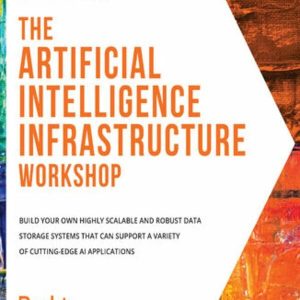Opis
Build machine learning algorithms using graph data and efficiently exploit topological information within your modelsKey FeaturesImplement machine learning techniques and algorithms in graph dataIdentify the relationship between nodes in order to make better business decisionsApply graph-based machine learning methods to solve real-life problemsBook DescriptionGraph Machine Learning provides a new set of tools for processing network data and leveraging the power of the relation between entities that can be used for predictive, modeling, and analytics tasks. You will start with a brief introduction to graph theory and graph machine learning, understanding their potential. As you proceed, you will become well versed with the main machine learning models for graph representation learning: their purpose, how they work, and how they can be implemented in a wide range of supervised and unsupervised learning applications. Youll then build a complete machine learning pipeline, including data processing, model training, and prediction in order to exploit the full potential of graph data. Moving ahead, you will cover real-world scenarios such as extracting data from social networks, text analytics, and natural language processing (NLP) using graphs and financial transaction systems on graphs. Finally, you will learn how to build and scale out data-driven applications for graph analytics to store, query, and process network information, before progressing to explore the latest trends on graphs. By the end of this machine learning book, you will have learned essential concepts of graph theory and all the algorithms and techniques used to build successful machine learning applications.What you will learnWrite Python scripts to extract features from graphsDistinguish between the main graph representation learning techniquesBecome well-versed with extracting data from social networks, financial transaction systems, and moreImplement the main unsupervised and supervised graph embedding techniquesGet to grips with shallow embedding methods, graph neural networks, graph regularization methods, and moreDeploy and scale out your application seamlesslyWho this book is forThis book is for data scientists, data analysts, graph analysts, and graph professionals who want to leverage the information embedded in the connections and relations between data points to boost their analysis and model performance using machine learning. The book will also be useful for machine learning developers or anyone who want to build ML-driven graph databases. A beginner-level understanding of graph databases and graph data is required. Intermediate-level working knowledge of Python programming and machine learning is also expected to make the most out of this book. Spis treści:Graph Machine LearningContributorsAbout the authorsAbout the reviewersPrefaceWho this book is forWhat this book coversTo get the most out of this bookDownload the example code filesDownload the color imagesConventions usedGet in touchReviewsSection 1 Introduction to Graph Machine LearningChapter 1: Getting Started with GraphsTechnical requirementsIntroduction to graphs with networkxTypes of graphsGraph representationsPlotting graphsnetworkxGephiGraph propertiesIntegration metricsSegregation metricsCentrality metricsResilience metricsBenchmarks and repositoriesExamples of simple graphsGenerative graph modelsBenchmarksDealing with large graphsSummaryChapter 2: Graph Machine LearningTechnical requirementsUnderstanding machine learning on graphsBasic principles of machine learningThe benefit of machine learning on graphsThe generalized graph embedding problemThe taxonomy of graph embedding machine learning algorithmsThe categorization of embedding algorithmsSummarySection 2 Machine Learning on GraphsChapter 3: Unsupervised Graph LearningTechnical requirementsThe unsupervised graph embedding roadmapShallow embedding methodsMatrix factorizationSkip-gramAutoencodersTensorFlow and Keras a powerful combinationOur first autoencoderDenoising autoencodersGraph autoencodersGraph neural networksVariants of GNNsSpectral graph convolutionSpatial graph convolutionGraph convolution in practiceSummaryChapter 4: Supervised Graph LearningTechnical requirementsThe supervised graph embedding roadmapFeature-based methodsShallow embedding methodsLabel propagation algorithmLabel spreading algorithmGraph regularization methodsManifold regularization and semi-supervised embeddingNeural Graph LearningPlanetoidGraph CNNsGraph classification using GCNsNode classification using GraphSAGESummaryChapter 5: Problems with Machine Learning on GraphsTechnical requirementsPredicting missing links in a graphSimilarity-based methodsEmbedding-based methodsDetecting meaningful structures such as communitiesEmbedding-based community detectionSpectral methods and matrix factorizationProbability modelsCost function minimizationDetecting graph similarities and graph matchingGraph embedding-based methodsGraph kernel-based methodsGNN-based methodsApplicationsSummarySection 3 Advanced Applications of Graph Machine LearningChapter 6: Social Network GraphsTechnical requirementsOverview of the datasetDataset downloadLoading the dataset using networkxNetwork topology and community detectionTopology overviewNode centralityCommunity detectionEmbedding for supervised and unsupervised tasksTask preparationnode2vec-based link predictionGraphSAGE-based link predictionHand-crafted features for link predictionSummary of resultsSummaryChapter 7: Text Analytics and Natural Language Processing Using GraphsTechnical requirementsProviding a quick overview of a datasetUnderstanding the main concepts and tools used in NLPCreating graphs from a corpus of documentsKnowledge graphsBipartite document/entity graphsBuilding a document topic classifierShallow learning methodsGraph neural networksSummaryChapter 8:Graph Analysis for Credit Card TransactionsTechnical requirementsOverview of the datasetLoading the dataset and graph building using networkxNetwork topology and community detectionNetwork topologyCommunity detectionEmbedding for supervised and unsupervised fraud detectionSupervised approach to fraudulent transaction identificationUnsupervised approach to fraudulent transaction identificationSummaryChapter 9: Building a Data-Driven Graph-Powered ApplicationTechnical requirementsOverview of Lambda architecturesLambda architectures for graph-powered applicationsGraph processing enginesGraph querying layerSelecting between Neo4j and GraphXSummaryChapter 10: Novel Trends on GraphsTechnical requirementsLearning about data augmentation for graphsSampling strategiesExploring data augmentation techniquesLearning about topological data analysisTopological machine learningApplying graph theory in new domainsGraph machine learning and neuroscienceGraph theory and chemistry and biologyGraph machine learning and computer visionRecommendation systemsSummaryWhy subscribe?Other Books You May EnjoyPackt is searching for authors like youLeave a review – let other readers know what you think
E-informatyka
tyłek, aglomeracje, wokanda nsa, anna sekielska, telefon na kartę bez umowy, odpisy z kw, art 32 konstytucji, porody, szczepienia kalendarz, papiery wartościowe, używanie, objawy zapalenia wyrostka, chruszczow, kolbego, bezpieczna umowa najmu mieszkania wzór, jak liczyć nadgodziny, praca australia, rezygnacja z umowy
yyyyy




